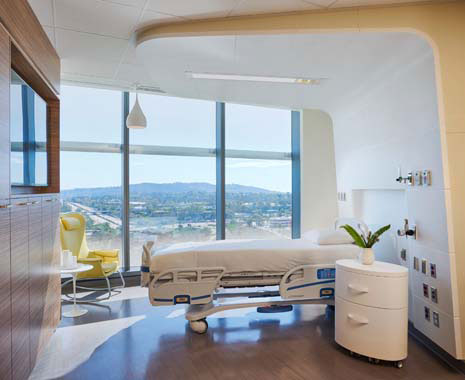The UC San Diego Health Jacobs Medical Center in La Jolla, Calif., was completed in November 2016, the product of an effort to transform what had begun as a community hospital setting for the University of San Diego into an academic medical center. “When we began the project, we took a step back and said, ‘Let’s imagine the future of the medical campus and design something that works and fits within the context of how the campus would grow and evolve in the future,” says Mehrdad Yazdani , design principal, Yazdani Studio of CannonDesign (Los Angeles) and lead designer on the project.
The $943 million project includes 540,000 square feet of new construction and 63,000 square feet of renovated space, the hallmark of which is a 10-story, 245-bed patient tower that houses advanced surgical care, cancer care, and women’s and infants’ care. Its location on campus supports a connection between research and clinical care, and positions UC San Diego (UCSD) Health for its bench-to-bedside goals.
The project was one of two Award of Merit winners in the 2017 Healthcare Design Showcase.
Here, we explore the three design elements most recognized by our jurors.
1. Sculptural headwall with integrated technology
Yazdani was a relative newcomer to the healthcare design sector, with UCSD Health Jacobs Medical Center his first standalone hospital project. Bringing a history of commercial, education, and residential design to the table, he saw an opportunity to strike a better balance in how patient rooms are approached: “Can we create a comfortable, symbiotic relationship between the utilitarian and the quality of the space?” The answer was a sculptural form that seamlessly integrates gas, lighting, electrical outlets, a patient lift, etc., using a high-design aesthetic. “It’s the idea of designing the headwall as if it’s a piece of furniture in your living room or a hotel room and collecting all the clinical and technology pieces into that piece of furniture,” he says.
The unit includes pieces and panels that are adjustable and removable, answering a desire by the client that the hospital not only be beautiful and state of the art but flexible enough to accommodate future needs, says Randy Leopold, senior director of healthcare architecture at UCSD. “Technology is the one place where you need the most flexibility, because in some sense they were designing in 2007, 2008, 2009 for technology that didn’t even exist. The headwall is a microcosm of that,” he says.
To determine the correct headwall solution, the team went through several design iterations, building mocks-ups and inviting users to comment and critique the design. The final design is scalable, too, allowing it to be used in various-sized patient rooms.
2. Access to gardens and natural light
Leopold says the hospital wasn’t so prescriptive in demanding details like stunning ocean views and elevated gardens, which were ultimately delivered. But that doesn’t mean they weren’t encouraged. “There’s always an expectation here of digging into those kinds of subtle things,” he says. And the location itself begged for those solutions with panoramic views to La Jolla, nearby canyons, and the Pacific Ocean beyond.
The team created more than 60 design concepts through computer modeling to create a building form that best took advantage of those views and best controlled the light. “We studied [the building form] endlessly, mocked it up, and looked at how much light it allowed, how much heat gain and glare it blocked, and to maximize views to enhance the patient experience,” Yazdani says.
Where needed, fritting was placed on windows to control heat gain and glare, while in the patient rooms, full-height windows were delivered. Additionally, there are several gardens and courtyards, some dedicated specifically to public, patient, or staff use only.
3. Operational efficiency
To answer an ownership goal for operational efficiency, the design team used client engagement and visioning sessions as a starting point to determine the design that would ultimately deliver on that request, says Carlos Amato, healthcare principal at CannonDesign (Los Angeles). These sessions included 513 meetings with 65 user groups (including clinicians, staff, patients, and family members) across 80 departments and with 150 design consultants.
Additionally, managing operational flow began in the programming/schematic phase and continued into design/development, with process mapping then employed to understand the current state to achieve an improved future state—and even improve upon design plans. “One example is a dedicated intake suite, which was planned as part of the original design. Using process mapping and other simulation testing, our team was able to eliminate the need for the intake suite in the final design by demonstrating to the client that technology could be used to provide the same level of operational efficiency without using the amount of space typically required,” Amato says.
Additionally, to better understand the experiences and processes of clinical care teams, the designers traveled to Cleveland Clinic with UCSD Health’s neurosurgery team, together spending hours observing surgeries. “Then a mock-up site was created to further develop and experiment with the surgical space and processes, allowing medical user groups to ‘play’ with the different configurations and test the model space,” he says—the results of which were refined over the course of 1.5 years before arriving at final design.
Jennifer Kovacs Silvis is editor-in-chief of Healthcare Design. She can be reached at [email protected].












